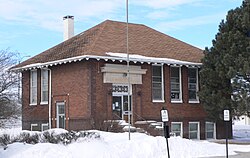United States historic place
| Plainview Carnegie Library | |
| U.S. National Register of Historic Places | |
 | |
  | |
| Location | Plainview, Nebraska |
|---|---|
| Coordinates | 42°21′2″N 97°47′36″W / 42.35056°N 97.79333°W / 42.35056; -97.79333 |
| Area | 0.4 acres (0.16 ha) |
| Built | 1916-1917 |
| Built by | Houx, Frank T. |
| Architect | J.C. Stitt |
| Architectural style | Prairie School |
| MPS | Carnegie Libraries in Nebraska MPS |
| NRHP reference No. | 93000056 |
| Added to NRHP | February 25, 1993 |
The Plainview Carnegie Library in Plainview, Nebraska is a Carnegie library which was built in 1916–1917. It was listed on the National Register of Historic Places in 1993.
It is a one-story 30 by 42 feet (9.1 m × 12.8 m) brick building with a raised basement. It has a hipped roof with wide eaves and modillions. It has Prairie Style details. It was designed by Norfolk, Nebraska architect J.C. Stitt and built by contractor Frank T. Houx.
Its lower level was renovated to include a children's reading room in 1977. In 1992 the building still served as a library.
Plainview was one of 68 communities in Nebraska that were awarded Carnegie library grant funds.
References
- ^ "National Register Information System". National Register of Historic Places. National Park Service. July 9, 2010.
- ^ Janyce Warneke (July 4, 1992). "National Register of Historic Places Registration: Plainview Carnegie Library / NeHBS# PC06-013". National Park Service. Retrieved April 15, 2017. With three photos from 1992.
- Kathleen Fimple (June 15, 1990). "National Register of Historic Places Multiple Property Documentation: Carnegie Libraries in Nebraska, 1899 - 1922". National Park Service. Retrieved April 15, 2017.
External links
 Media related to Plainview, Nebraska Carnegie Library at Wikimedia Commons
Media related to Plainview, Nebraska Carnegie Library at Wikimedia Commons
| U.S. National Register of Historic Places | |
|---|---|
| Topics | |
| Lists by state |
|
| Lists by insular areas | |
| Lists by associated state | |
| Other areas | |
| Related | |
This article about a property in Nebraska on the National Register of Historic Places is a stub. You can help Misplaced Pages by expanding it. |